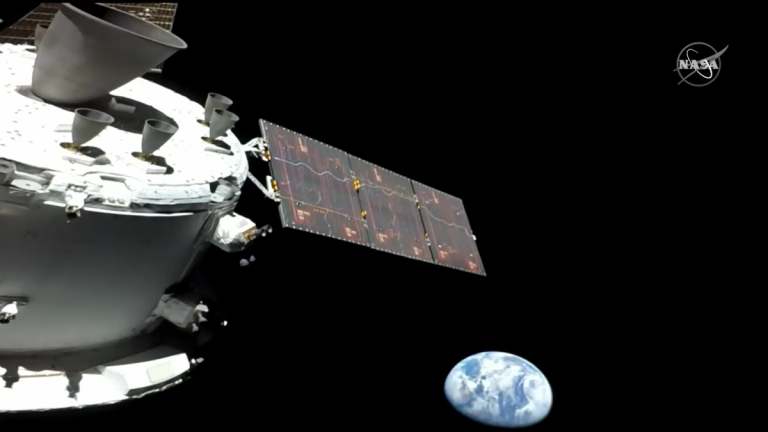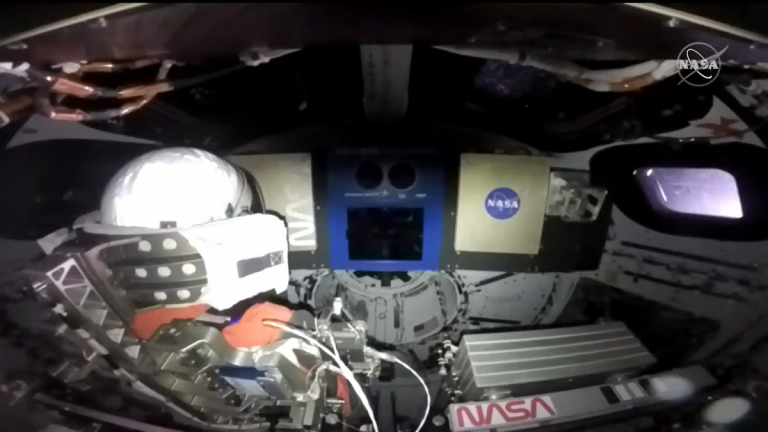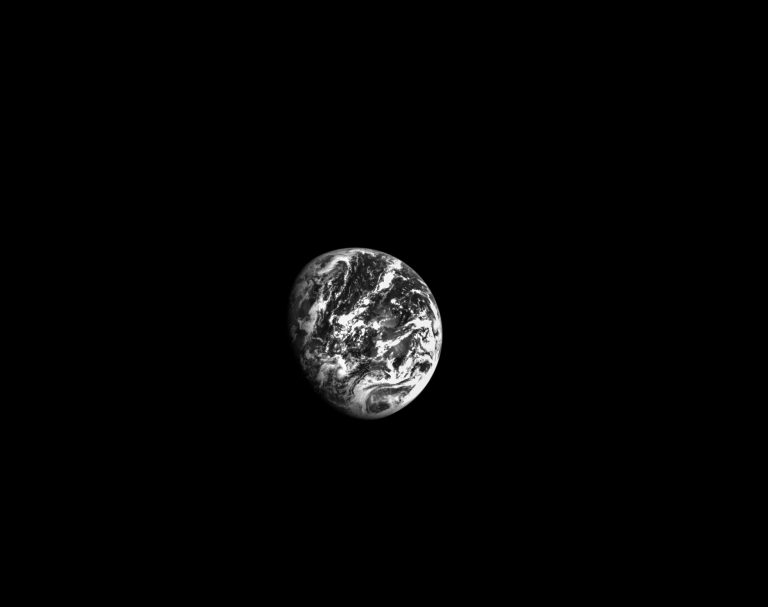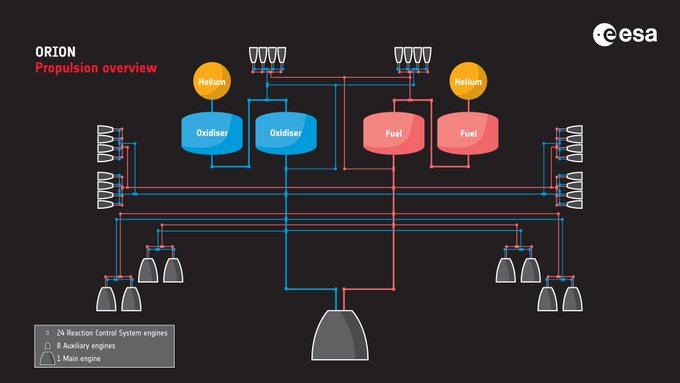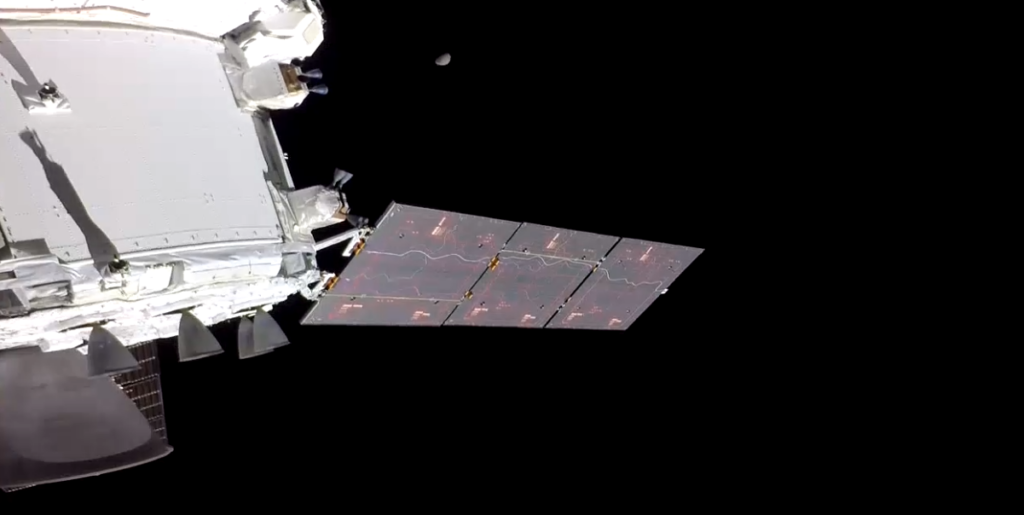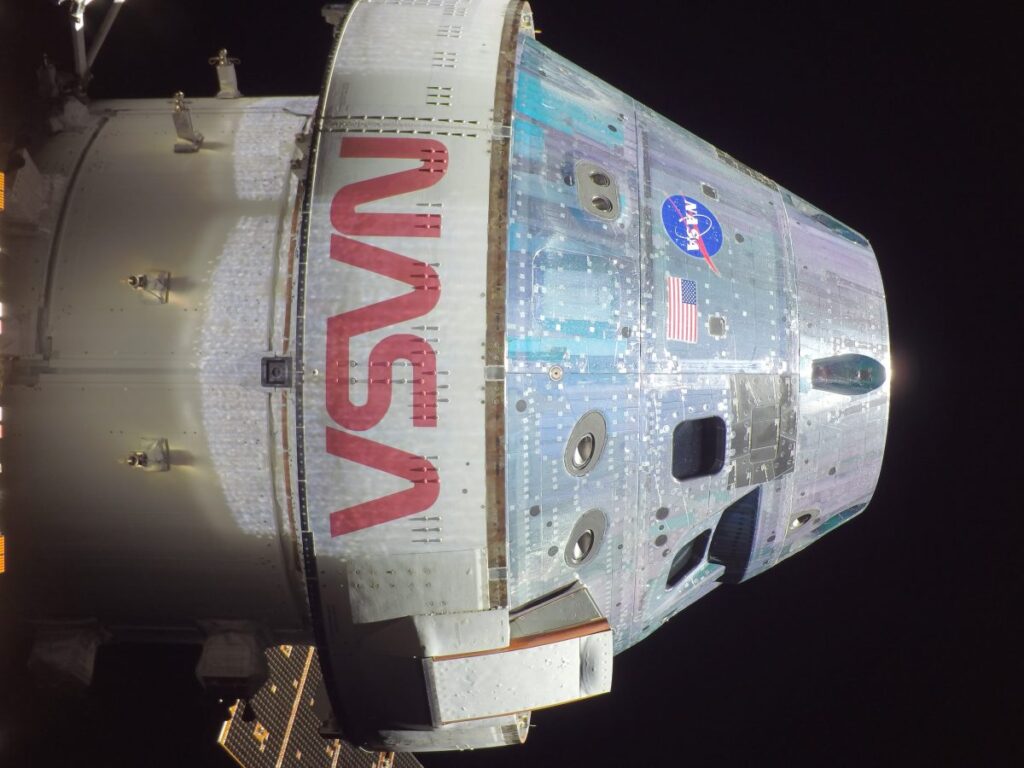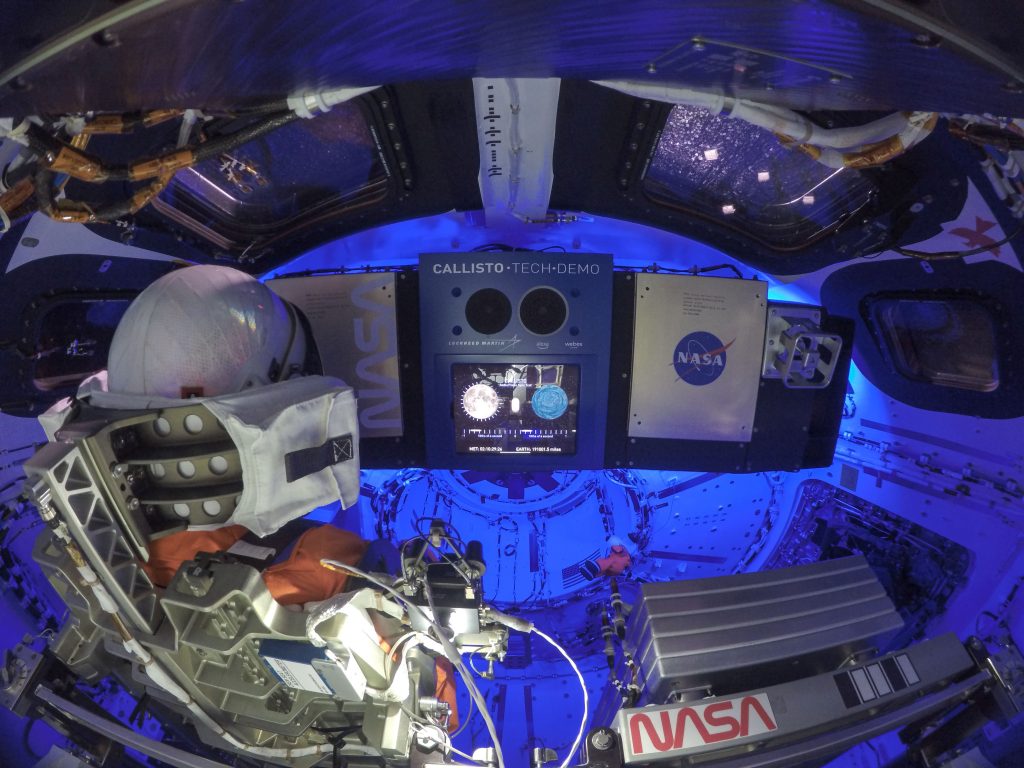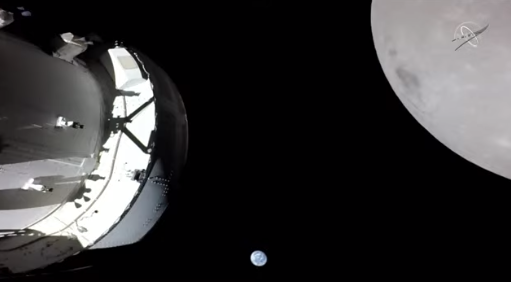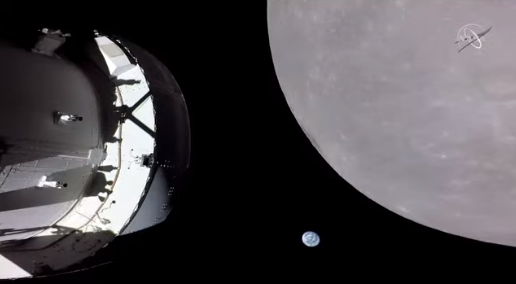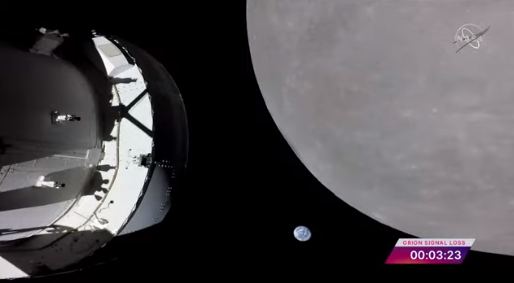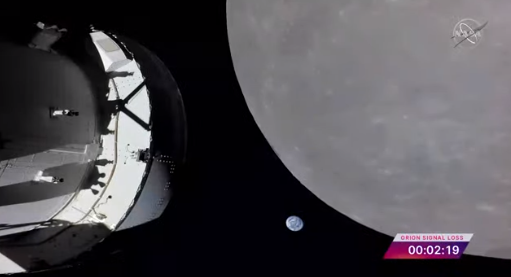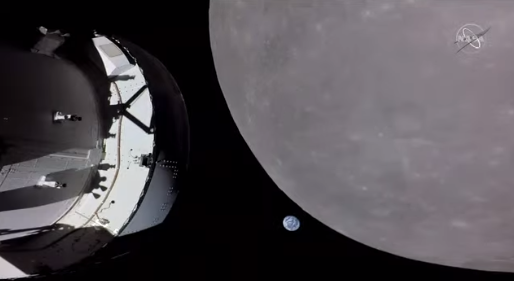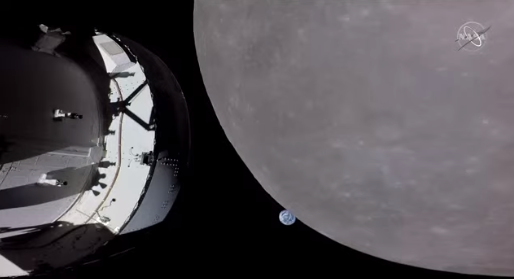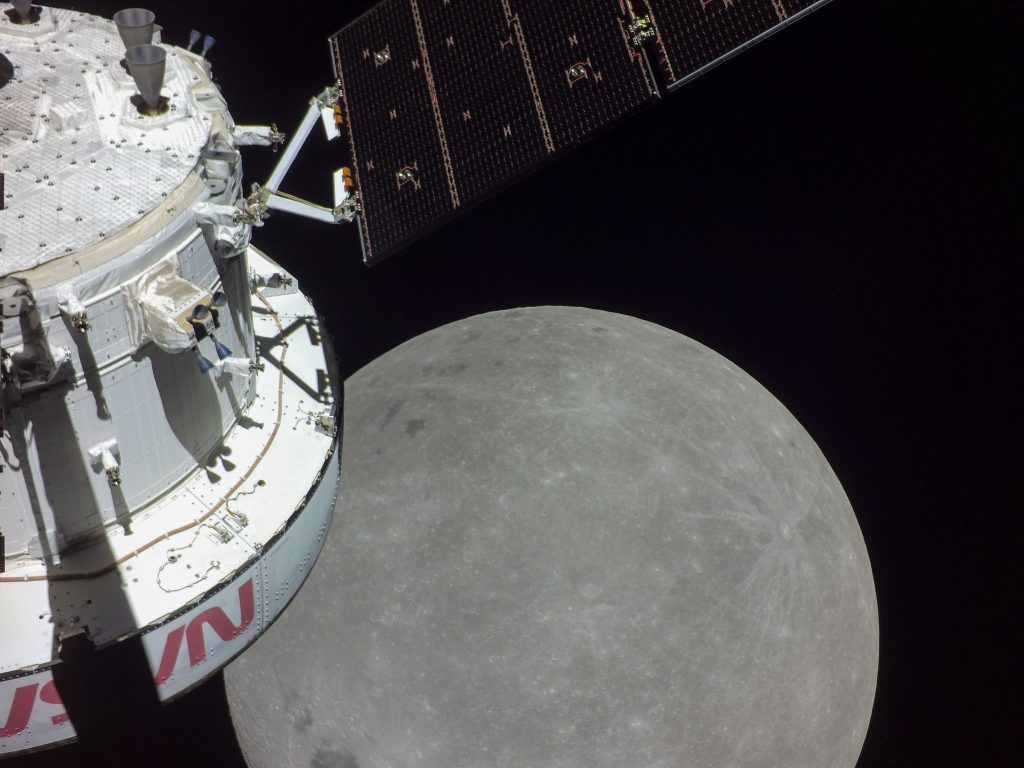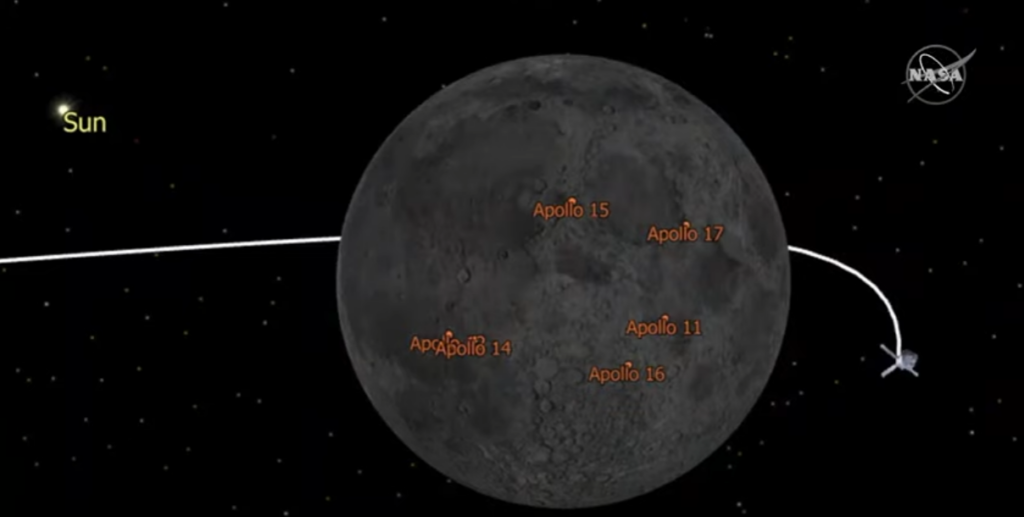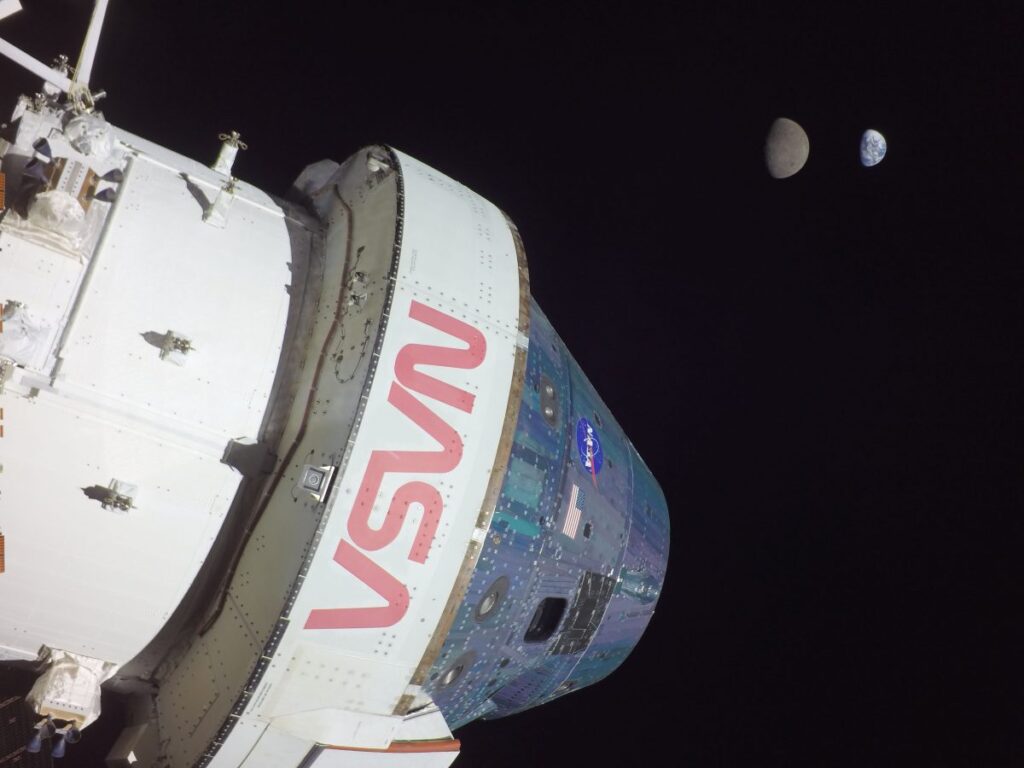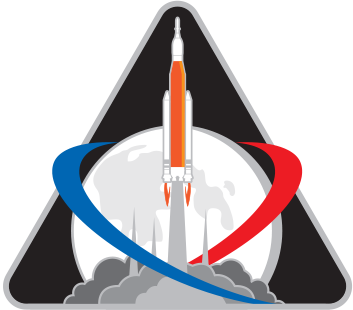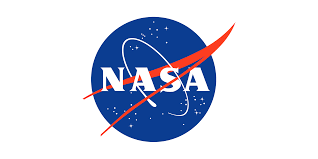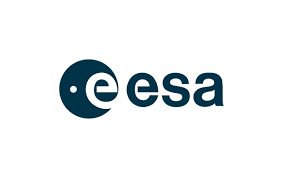Artemis I sequence of events
Rollout to the pad (Date)
- 01-10-2022 Artemis launch contraints (including rollout contraints).
- 27-10-2022 Call for rollout.
- 28-10-2022 Poll Go/No for rollout. SLS on Mobile Launcher Platform (MLP) leaving the VAB for Launch Pad 39B with Crawler Transporter (CT). It takes about 8 hours from the VAB to the Lauch Pad.
- 02-11-2022 All platforms in the VAB in retract position.
- 04-11-2022 Rollout SLS Artemis I.
Preparations on the pad (Date)
- 04-11-2022 Extend the crew access arm.
- 04-11-2022 Check communication.
- 04-11-2022 Check telemetry.
- 04-11-2022 Commodity connects.
- 05-11-2022 Orion hatch opened and closed for payload installations (1).
- 05-11-2022 Engineering tests.
- 05-11-2022 Preparation to fuel the solid boosters hydralic power.
- 05-11-2022 Launch countdown preps.
- 06-11-2022 Mission Management Team (MMT).
- Decision: SLS stays on launch pad with upcoming hurricane Nicole.
- 09-11-2022 Hurricane.
- 10-11-2022 Inspection SLS, Orion and mobile launcher after hurricane.
- 11-11-2022 Fixing several minor items from the hurricane.
- 11-11-2022 Engineers removed the hard cover over the launch abort system window installed before the storm and will inspect the window to confirm it is in good condition for launch.
- 11-11-2022 Powering up rocket and spacecraft elements to confirm all systems are healthy.
- 12-11-2022 Powered health checks.
- 13-11-2022 Standard final software and hardware-related tests required before launch.
- 13-11-2022 Mission Management Team (MMT).
- Review preparations for launch.
- Decision: Go to proceed toward launch attempt on 16-11-2022.
- 14-11-2022 Start countdown clock 01:54 a.m. EST (07:54 CET) (+6).
- 14-11-2022 Detailed analysis of several feet of delaminated caulk where the ogive on Orion’s launch abort system meets the crew module adapter. The analysis will assess risk should it come loose during launch.
- 14-11-2022 Remove and replace a component of an electrical connector on the hydrogen tail service mast umbilical ground-side plate. Engineers continue to see some inconsistent data provided through the connector, despite replacing the cable to the connector earlier in the week. Engineers have redundant sources for the information provided through the connector and it is not an impediment to launch.
- 14-11-2022 Mission Management Team (MMT) – Flight Readiness Review (FRR).
- Review additional analysis associated with caulk on Orion’s launch abort system that came loose during Hurricane Nicole.
- Decision: Go to proceed toward launch attempt on 16-11-2022.
- 14-11-2022 Loading toxic hydrazine fuel into the steering system of the two boosters.
- 14-11-2022 Orion hatch reopened and closed for payload installation (2)
- Radiation dosimeters.
- Radiation hardware.
- Biology experiments.
- Voice-activated crew interface technology (Callisto).
- 15-11-2022 Orion hatch reopened and closed for payload installation (3).
- Zero-g indicator (Snoopy).
- Removing soft covers from windows and seats.
- 15-11-2022 Hatch closed.
- 15-11-2022 Removing access platforms.
Hours and minutes before launch (Time to opening launch window)
48:00:00 Launch Teams (LT, LCT) arrive at their stations at Launch Control Center (LCC at KSC, Florida). About 48 hours before the opening of the launch window.
- 46:00:00 Weather report review:
- Report produced by NASA and National Hurricane Center.
- Proton stream has impact on the decision.
- In case of a hurricane back to the VAB.
- Leaving the launch pad for the VAB takes 3,5 days to reconfigure.
- 45:00:00 Launch Management Team: Activated. Weather, technical and safety discussed.
- 45:00:00 Weather: Threat of lightning within 5 miles from the pad must be below 20%.
- 45:00:00 Launch Management Team (LMT): Launch Readiness Review (LRR):
- Decision: Go to proceed toward launch attempt on 16-11-2022.
- 45:00:00 Start countdown.
- 44:00:00 NOTAM Exclusion zone publication.
- 43:00:00 Mission Managers Briefing.
- 42:00:00 Fill the water tank for the Sound Suppression Water System (SSWS).
- 40:00:00 Orion Spacecraft is powered up.
- 35:00:00 Core Stage (CS) powered up and charging for flight.
- 32:00:00 Core Stage composite overwrapped pressure vessel (COPV) pressurization to Flight Pressure (L-32M – L-23H).
- 31:00:00 The ICPS is powered down (L-31H – L-30H30M).
- 31:00:00 Charge Orion flight batteries to 100% (L-31H – L-27H).
- 30:50:00 Final preparations of the four RS-25D engines.
- 30:05:00 Orion Crew Module (CM) hatch closed.
- 28:50:00 Leak checks are completed and the hatch on the Launch Abort System (LAS) is closed.
- 28:00:00 Charge Core Stage flight batteries (L-28H – L-22H).
- 26:05:00 Crew access arm retract.
- 25:00:00 Communications configuration.
- 25:00:00 Core Stage configuration for flight.
- 25:00:00 ICPS configuration for flight.
- 24:00:00 Launch Management Team (LMT):
- Decision: Go for tanking preparations.
- 22:00:00 Preparations for final configuration for tanking.
- 21:00:00 Side flame deflectors are moved into place.
- 19:30:00 Interim Cryogenic Propulsion Stage (ICPS) is powered up for launch. ICPS consists of Forward Skirt (houses computers and avionics), LOX Tank, Intertank, LH2 Tank, Engine section. Cryogenic means very low temperatures (L-19H30M – L-16H30M).
- 13:00:00 All non-essential personnel leave Launch Complex 39B (L-13H – L-11H).
- 11:45:00 Air-to-gaseous nitrogen (GN2) changeover and vehicle cavity inerting (L-11H45M – launch).
- 11:15:00 Ground Launch Sequencer (GLS) activation (L-11H15M – 10H15M).
- 11:00:00 Orion Mode to abort pre launch: NASA has acquired several MRAPs to station near the launch pad, should there be time for the crew to evacuate the vehicle. One will be occupied by emergency rescue personnel, while the other will stand empty behind a blast shelter. Pad emergency egress enables astronauts and engineers to quickly escape the perimeter of the rocket. Both zip-lines and roller coasters were at one time studied for this purpose.
- 10:40:00 Built in countdown Hold. Duration: 3,5 hours (L-10H40M – L-7H10M).
- 10:40:00 Launch team conducts a weather and tanking briefing (L-10H40M – L-9H50M).
- 09:00:00 Built in countdown Hold L-9. Duration:120 minutes. T-time stopped while L-time continues to advance. Hold on 06:40:00 on the countdown clock.
Tanking process (LOX and LH2 partly simultaneously for balance, duration cryogenic tanking process: 6 hours).
- 09:40:00 Mission Management Team (LMT):
- Weather is ok (80%). Thick layer of clouds.
- 14 minutes meeting, clean board.
- Decision: Go for cryogenic propellant loading.
- 09:15:00 Core Stage LOX transfer line (cryosphere to SLS) chilldown (L-9H15M – L-9H).
- 09:15:00 Core Stage LH2 transfer line (cryosphere to SLS) chilldown (L-9H15M – L-8H45M).
- 09:00:00 Core Stage LOX main propulsion system chilldown (L-9H – L-8H20M).
Tanking LOX Core Stage (top)
- Data: Core Stage Top: 99,000 Gallons / 375.000 Liters, 294 F / -181 C.
- 08:20:00 Core Stage LOX slow fill (L-8H20M – L-8H5M).
- 08:05:00 Core Stage LOX fast fill (L-8H5M – L-5H15M).
- 05:15:00 Core Stage LOX topping (L-5H15M– L-5H5M).
- 05:05:00 Core Stage LOX replenish (L-5H5M – launch).
Tanking LH2 Core Stage (bottom)
- Data: Core Stage Bottom: 538,000 Gallons / 2.037.000 Liters, 426 F / -254 C.
- 08:45:00 Core Stage LH2 slow fill start (L-8H45M – L-7H50M).
- 07:50:00 Core Stage LH2 fast fill (L-7H50M – L-6H10M).
- 06:10:00 Core Stage LH2 topping (L-6H10M – L6H5M).
- 06:05:00 Core Stage LH2 replenish (L-6H5M – launch). Red crew at the pad, addressing replenish valve LH2 leak.
Kick start bleed test
- 07:40:00 Engine bleed kick start test LH2 RS25 (L-7H40M – L-7H20M).
- 07:07:00 Optical checks on cracks in the Core Stage continued.
- 07:00:00 Built in countdown Hold L-7. Duration: 10 minutes.
Tanking ICPS
- 05:20:00 ICPS LH2 ground support equipment and tank chilldown (L-5H20M – L-5H).
- 05:05:00 ICPS LOX main propulsion system chilldown (L-5H5M– L-4H45M).
- 05:05:00 ICPS LH2 fast fill start (L-5H5M – L4H5M).
- 04:55:00 ICPS LOX fast fill (L-4H55M– L-4H10M).
- 04:10:00 ICPS LOX validation and leak test (L-4H10M – L-3H40M).
- 04:00:00 ICPS LH2 validation and leak test (L-4H – L-3H40M).
- 03:40:00 ICPS LH2 tank topping start (L-3H40M – L-3H25M).
- 03:25:00 ICPS LH2 replenish (L-3H25M – launch).
- 03:40:00 ICPS LOX topping (L-3H40M – L-3H20M).
- 03:20:00 ICPS LOX replenish (L-3H20M – launch).
- 02:55:00 ICPS LOX validation and leak test (L-2H55M – L-2H30M).
- 02:50:00 ICPS LH2 replenish (L-2H50M – launch).
- 02:30:00 ICPS LOX topping (L-2H30M – L-2H10M).
- 02:10:00 ICPS LOX replenish (L-2H10M – launch).
- 04:20:00 Orion communications system activated (RF to mission control). Orion Launch Communications Segment (LCS) activated. Radio Frequency (RF) to Mission Control Center (MCC, Houston). Near Space Network (NSN).
- 02:55:00 ICPS/Space Launch System (SLS) telemetry data verified with Mission Control Center and SLS Engineering Support Center (L-2H55M – L-2H45M).
Status update 16-11-2022 (L-time and T-time)
Status 16-11-2022 L=00:01:12 (to opening launch window)
- Radar asset down (ethernet switch). Now in repair. Range 45 is No Go.
- Core Stage LH2 leak caused a delay earlier in the process. Upper Stage. Now in fast fill. Running.
Status 16-11-2022 L=00:20:00
- Radar asset: Ethernet switch replaced. Open loop test of the Flight Termination System (FTS) in progress. Range is No Go.
- Core Stage LH2 now 80%. Running.
Status 16-11-2022 L=00:05:00
- FTS: Open loop test FTS in progress. Range is No Go.
- Core Stage LH2: 95%. Running.
- Cork seen between Orion and SM: Not blocking.
- Extending the hold. Entering the two-hour launch window. Switching to T-time.
Status 16-11-2022 T-10 and holding
- FTS: Testing going on. Range is Go.
- Core Stage: Finished.
- Evaluation how much work needs to be done before entering the 00:15:00 poll Go for terminal count. Done.
- Pending new launch time. There are cut-outs when there can be no launch (seconds, minutes).
Minutes and seconds before launch (T-time)
- 00:40:00 Built in countdown Hold L-40. Duration: 30 minutes.
- Final NASA Test Director briefing is held (L-40M).
- T-time is stopped while L-time continues to advance.
- During the launch window the Trans Lunar Injection moment (TLI) is shifting.
- Clock is T-10 and holding.
- 00:20:00 Launch Management Team (LMT):
- 00:20:00 The launch director polls the team to ensure they are Go for launch.
- All communication one loop.
- All managers one by one
- Decision: Go for terminal count.
- 01:47:44
Terminal count – Automation (T-time)
- 00:10:00 Ground Launch Sequencer (GLS) initiates terminal count (T-10M). GLS does the countdown.
- 00:06:00 Ground Launch Sequencer (GLS) gives a Go for Core Stage tank Pressurisation (brings tanks to flight levels).
- 00:06:00 Orion ascent pyros are armed (T-6M).
- 00:06:00 Orion set to internal power (T-6M)
- 00:05:57 Core stage LH2 terminate replenish (T-5M57S).
- 00:05:00 GLS gives a Go for Flight Termination System (FTS) to Arm (align the firing chain for a destruction of the vehicle in flight when needed).
- 00:04:00 Core Stage LOX Replenish termination.
- 00:05:00 GLS is go for flight termination system (FTS) arm (T-5M).
- 00:04:40 GLS is go for LH2 high flow bleed check (T-4M40S).
- 00:04:00 GLS is Go for Core Stage Auxiliary Power Unit (APU) (needed for hydrolic systems).
- 00:04:00 Core Stage APU starts (T-4M).
- 00:04:00 Core stage LOX terminate replenish (T-4M).
- 00:03:30 ICPS LOX terminate replenish (T-3M30S).
- 00:03:10 Go for Perch sequence 4 (final healing in perch of the RS-25 engines).
- 00:02:02 Go for Upper Stage to Internal Power.
- 00:01:56 ICPS switches to internal battery power.
- 00:01:30 Core stage switches to Internal power.
- 00:01:20 ICPS Enters terminal countdown mode.
- 00:00:50 ICPS LH2 Replenish termination.
- 00:00:33 GLS sends Go for Automated Launch Sequencer (ALS).
- 00:00:29 Core stage flight computer to ALS.
- 00:00:15 Sound Suppression System (SSS) activated (water flow under the launch pad).
- 00:00:12 Hydrogen burn off igniters initiated.
- 00:00:10 GLS sends the command for Core Stage Engine Start.
- 00:00:06 RS-25D engines startup (T-6.36 seconds).
- ENGINES: 4 x RS-25D Engines, Aerojet RocketDyne. Together, the set of four-engines generates more than 2 million pounds of thrust for the climb to overcome the pull of Earth’s gravity. The engines will burn more than 90,000 gallons of liquid hydrogen and liquid oxygen every minute before the Core Stage separates from the ICPS and Orion. Burn: 8 minutes (3 minutes boosters plus core stage + 8 minutes core stage only)
- 00:00:00 Umbilical separation.
- 00:00:00 Boosters ignition.
- ENGINES: 2 x Solid Booster Ignition engines. Northrop Grumman. These motors ignite the solid propellant in each solid booster at Liftoff. Burn: Less than a second.
- ENGINES: 2 x Solid Boosters. Northrop Grumman. Together the twin boosters provide more than 75% of the total thrust at liftoff. Each booster generates a maximum thrust of 3.6 million pounds and will burn 6 tons of solid propellant every second before separating from the Core Stage. Burn: 3 minutes
Liftoff and Reconfiguration (First hour in flight). Mission Elapsed Time (MET-time, hh:mm:ss)
Minutes and seconds (in flight) MET
00:00:00 MET (Flight Day 1 16-11-2022 Wednesday)
- 00:00:00 Liftoff and handover to the Flight Control Team. Wednesday 16-11-2022 at 01:47:44 a.m. EST (07:47:44 CET). Start MET-time. VIDEO
- 00:00:00 Orion Mode 1 to abort: During the first 120 seconds of flight, up to the jettisoning of the solid-fueled boosters at 300,000 feet (91 km), the Orion crew module (CM) will separate from the rest of the rocket propelled by the LAS. The Orion LAS has a set of steering rockets that will steer the spacecraft away from the malfunctioning SLS, as well as prepare the spacecraft for both separation and splashdown. The tower will then be jettisoned 14 seconds later and the hypergolic fuel on the Orion CM would be automatically released at a pre-determined altitude.
- 00:00:07 Cleared the tower.
- 00:00:07 Initiate roll to azimuth maneuver (roll for the heads-down position).
- ENGINE: 1 x Launch Abort System (LAS) Abort Engine. Northrop Grumman. In the event of an emergency on the launch pad or during ascent, the abort motor fires, producing about 400,000 pounds of thrust, to quickly pull the crew capsule away from danger. Burn: 3 seconds.
- ENGINE: 1 x Launch Abort System (LAS) Attitude Control Engine. Northrop Grumman. As the abort motor pulls Orion away from the rocket during an emergency on the pad or during launch, the LAS attitude control motor fires and provides variable thrust as needed to stabilize the crew capsule and steer it in any direction to re-orient it before the LAS is jettisoned in preparation for parachute deployment and splashdown. The motor can exert up to 7,000 pounds of steering force in any direction. Burn: 30 seconds.
- 00:00:54 Speed Mach 1 (supersonic).
- 00:01:03 Abort boundary Artemis I. If a single engine is lost, still able to make first mission priority objectives. Enough performance between ICPS upper stage with adding energy from Orion to make a highly eliptical orbit and/or Lunar flyby.
- 00:01:10 Maximum Dynamic Pressure (Max Q). Throttle down this period.
- 00:02:10 Solid Rocket Separation (Rocket Boosters jettison). (SRB SEP)
- 00:02:12 Start close loop quidance control. Targeting insertion point.
- 00:03:11 SM Fairings jettison (3 panels) to expose the SM and Solar Arrays. Space adaptor: Attaches Orion to the rocket when the vehicle is on its way to space, the two fairings are jettisoned. (SAJ SEP)
- 00:03:23 Abort boundary to press to MECO (00:08:01). With a single engine lost, a full Artemis I mission can be executed.
- 00:03:30 Launch Abort System (LAS SEP) jettison to expose the Orion CM.
- ENGINE: 1 x Launch Abort System (LAS) Jettison engine. Aerojet RocketDyne. The motor fires during a normal launch sequence to separate the launch abort system from Orion when it is no longer needed or following an abort to allow Orion to deploy parachutes for a safe splashdown in the ocean. In the unlikely event of an emergency during launch or ascent, the jettison motor will provide approximately 40,000 pounds of thrust to separate the LAS from the crew module during an abort. Burn: 1,5 seconds.
- 00:03:40 Orion Mode 2 to abort: After the LAS is jettisoned, the Orion will separate as a whole from the SLS and either use its large AJ-10 engine or smaller control engines to maneuver from the rocket. The Orion will use the AJ-10 engine to propel the spacecraft to a desired separation point, in which then the Orion CM would land in either western Spain or Morocco on “due east” (i.e., lunar) flights, or in Ireland or the United Kingdom on ISS-bound flights. A splashdown in the eastern Atlantic Ocean would only be a contingency (untargeted abort splashdown).
- 00:00:00 Orion Mode 3 to abort: The SLS would propel the Orion into an initial orbit, upon which the spacecraft will immediately separate, and then perform a retrofire that will allow the Orion CM to splashdown in the Pacific Ocean off the U.S. West Coast, or make a ground landing at either Edwards Air Force Base in California or White Sands Space Harbor in New Mexico.
- 00:05:24 Solid Rocket Booster (SRB) splashdown in the Atlantic.
- 00:07:26 Orion Mode 4 to abort: If the SLS suffers less-than-ideal performance during the initial orbit insertion, it can be restarted 45 minutes later to place the Orion into a less than ideal orbit that can be corrected with the on-board propellant reserves later in the flight. This is similar to the Shuttle’s Abort To Orbit (ATO) profile, but depending upon the stable orbit reached, it may require NASA to end the mission with a landing at either Edwards or White Sands within a 24-hour period.
- 00:08:01 Core Stage Main Engine Cut Off (MECO).
- 00:09:00 Core Stage and ICPS Separation. (SLS SEP).
- 00:19:00 Orion Solar Arrays Wing (SAW open) deploy (ESA Netherlands). Takes 12 minutes to deploy (00:30:00 finished). To power batteries of Orion. A failed Solar Array deploy with a crew aboard means a premature abort of the mission (not for Artemis I).
- 00:52:56 ICPS Perigee Raise Maneuver Burn. (Orbital Raise Maneuver, PRM burn/PRM cuttoff): ICPS RL10 engine fires to boost the spacecraft in a higher orbit around the Earth (from 16 miles to 100 miles):
- ENGINE: RL10-B2 Engine (First burn). United Launch Alliance (ULA). Raises the Orion spacecraft after Core Stage separation to put the ship in a stable orbit around the Earth. First burn: 20 seconds.
Reconfiguration (Second hour in flight) (MET-time, hh:mm:ss)
Hours and minutes
- 01:29:27 Trans Lunar Injection Burn (TLI burn): ICPS RL10 engine To increase spacecraft velocity to send Orion on a trajectory towards the Moon.
- ENGINE: RL10-B2 Engine (Second burn). (ICPS TLI Burn). United Launch Alliance (ULA). Will generate 24,750 pounds of thrust to propel the Orion spacecraft out of Earth’s orbit to set it on its precise trajectory to the Moon. The RL10 will boost Orion for 7,700 miles before separating from the spacecraft. Second burn: 18 minutes.
- 01:44:00 Core Stage Pacific splashdown in pieces. In between Hawaii and California.
- 01:57:36 Orion/ICPS separation: Orion separate from the ICPS an heads towards the Moon to continue the Artemis Mission (ICPS/Orion Separation). USS-1 Upper Stage separation burn.
- Through orbital debree.
- Pass GPS Satellites.
- Pass Geo Stationary Satellites.
- Through Van Allen Radiation Belts.
- 02:10:00 Handover to Lead Flight Director.
Orion and SM heading for the Moon (MET-time, hh:mm:ss)
- 03:25:00 ICPS Disposal Burn.
- 03:40:00 First Release CubeSat from Orion Stage Adapter. Next CubeSats at 05:10:00, 5:33:00, 6:03:00, 7:03:00 and 8:03:00. Total of 10.
- 07:45:32 Outbound Trajectory Correction-1 (OTC-1) burn: Adjust trajectory for lunar flyby to Distant Retrograde Orbit (DRO) and test the OMS-E. Poll for OTC-1 is Go. The solar panels and Orion rotate in the correct position in preparation for the OTC burn. 30 seconds burn. Outbound Trajectory Correction (OTC) burn: Orion’s service module performs several burns to ensure the spacecraft remains on the correct trajectory during the outbound portion of the flight.
- Propulsion elements, prop system in space:
- ENGINE: 1 x Orbital Maneuvering System Engine (OMS-E). Aerojet RocketDyne. This is the main engine on the Service Module (SM) that will provide the primary propulsion for Orion’s major in-space maneuvers as it travels around the Moon. The engine provides 6,000 pounds of thrust and is equipped to steer the spacecraft. It can also be used in some abort cases to safely return Orion to Earth. Burn: Less than 1 minute to more than 16 minutes. This engine was used in 19 space shuttle flights.
- ENGINES: 8 x Fixed 490N Auxiliary Thrusters (model R-4D-11). Aerojet RocketDyne .These are fixed at the bottom of the SM to provide trajectory corrections and as a backup to the main engine. Each provide about 100 pounds of thrust. The auxiliary engines can provide steering during burns by pulsing on and off. Burn: Less than 1 minute up to 45 minutes.
- ENGINES: 24 x Reaction Control System 220N Engines (RCS, 6 pods x4). ArianeGroup. These engines are in fixed positions and can be fired individually as needed to move the spacecraft in different directions or rotate it into any position. Each engine provides about 50 pounds of thrust. Burn: From milliseconds up to one hour.
Outbound Coasting to the Moon Phase, 4 days (MET-time, dd:hh:mm)
00:00:00 MET (Flight Day 1 16-11-2022 Wednesday)
- Modal survey: Test to verify that the models and simulations used to design Orion’s solar array wings accurately reflect the motion that is occurring in flight. This was accomplished by firing Orion’s reaction control system thrusters and observing how the solar array wings react to that specific firing sequence.
- Each solar array moved to a different position as the Integrated Communications Officer, or INCO, tested the WiFi transfer rate between the camera on the tip of the solar array panels and the camera controller. The goal was to determine the best position to most efficiently transfer imagery files.
- Calibrating optical navigation system.
- Gathered imagery using the spacecraft’s cameras.
- First images from Earth made by Orion cameras published. (16-11-2022).
01:00:00 MET (Flight Day 2 17-11-2022 Thursday)
- 01:00:00 Orion performed a second Outbound Trajectory Correction burn (OTC-2) (5) at 6:32 a.m. EST using the auxiliary thrusters on the European Service Module (ESM), which will be used for most trajectory correction burns.
- Teams collected additional images with the optical navigation camera. Orion used its optical navigation camera to snap black and white photos of planet Earth. Orion uses the optical navigation camera to capture imagery of the Earth and the Moon at different phases and distances, providing an enhanced body of data to certify its effectiveness as a method for determining its position in space for future missions under differing lighting conditions.
- Activating of the Callisto payload.
02:00:00 MET (Flight Day 3 18-11-2022 Friday)
- Halfway to the Moon.
- Orion’s cameras used to inspect the crew module thermal protection system and European Service Module.
- The Integrated Communications Officer (INCO), commands cameras on the four solar array wings to take still images of the entire spacecraft, allowing experts to pinpoint any micrometeoroid or orbital debris strikes. The team in mission control at NASA’s Johnson Space Center in Houston will review the imagery following the survey.
- Over the past few days, a team assessed anomalous star tracker data that correlated with thruster firings. Star trackers are sensitive cameras that take pictures of the star field around Orion. By comparing the pictures to its built-in map of stars, the star tracker can determine which way Orion is oriented.
- NASA also has received updates from teams associated with the 10 CubeSats that were delivered to space on a ring attached to the Space Launch System rocket’s upper stage. All 10 CubeSats were successfully deployed via timer from the adapter. The CubeSats’ individual missions are separate from Artemis I.
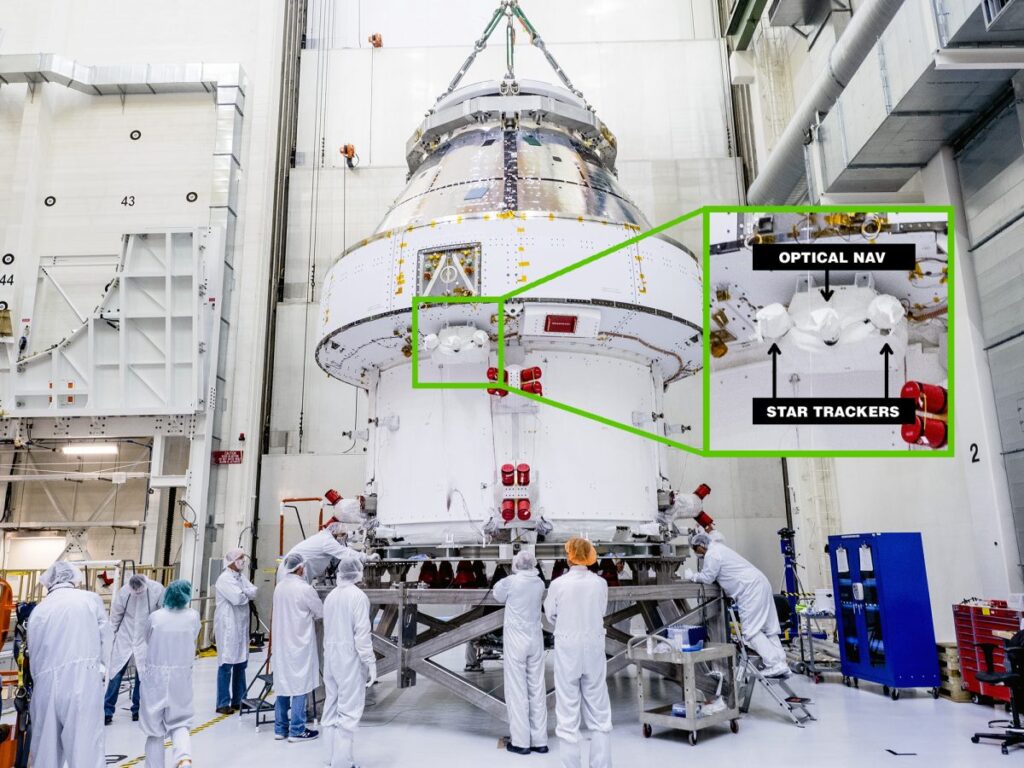
03:00:00 MET (Flight Day 4 19-11-2022 Saturday)
- Mission Management (MM) polls the team to commit to the Outbound Powered Flyby (OPF) burn.
- Decision: Go for Outbound Powered Flyby (OPF).
- Flight controllers moved each solar array to a different position to test the strength of the WiFi signal with the arrays in different configurations.
- The Integrated Communications Officer (INCO) tested the WiFi transfer rate between the camera on the tip of the solar array panels and the camera controller. The goal was to determine the best position to most efficiently transfer imagery files. Teams learned that having multiple cameras on at once can impact the WiFi data rate, and therefore, future solar array wing file transfer activities will be accomplished from one solar array wing at a time to optimize transfer time.
- The Emergency, Environmental, and Consumables Manager (EECOM) tested Orion’s radiator system. Two radiator loops on the spacecraft’s European Service Module help expel excess heat generated by different systems throughout the flight. Flight controllers are testing sensors that maintain the coolant flow in the radiator loops, switching between different modes of operation and monitoring performance. During speed mode, the coolant pumps operate at a constant rate. This is the primary mode used during Artemis I. Flow control mode adjusts the pump speed as needed to maintain a constant flow through the system. The flight test objective is to monitor system performance and the accuracy of flow sensors to characterize the stability of this mode of operation. Each loop is monitored in flow control mode for 72 hours to provide sufficient data for use on future missions.
- The guidance, navigation, and control officer (GNC), performed the first of several tests of the star trackers that support Orion’s navigation system. Star trackers are a navigation tool that measure the positions of stars to help the spacecraft determine its orientation. In previous flight days, engineers evaluated initial data to understand star tracker readings correlated to thruster firings. Engineers hope to characterize the alignment between the star trackers that are part of the guidance, navigation and control system and the Orion inertial measurements units, by exposing different areas of the spacecraft to the Sun and activating the star trackers in different thermal states.
- Overnight, engineers in mission control will uplink large data files to Orion to better understand how much time it takes for the spacecraft to receive sizeable files.
04:00:00 MET (Flight Day 5 20-11-2022 Sunday)
- OTC-3 Correction burn at 6:12 a.m. CST (+7 = 13:12 CET) firing the auxiliary thruster engines for a duration of 6 seconds at a rate of 3.39 feet per second to accelerate Orion and adjust the spacecraft’s path while en route to the Moon.
- Engineers activated the Callisto payload, Lockheed Martin’s technology demonstration in collaboration with Amazon and Cisco. Callisto will test voice-activated and video technology that may assist future astronauts on deep space missions.
- Captured imagery of the Moon using the optical navigation camera.
- Captured imagery of the Earth and the Moon at different phases and distances will provide an enhanced body of data to certify its effectiveness as a location determination aid for future missions under changing lighting conditions.
- Entered into the lunar sphere of influence at 1:09 p.m. CST (20:09 CST). Lunar gravity assist. Enter lunar influence: Orion enters the lunar sphere of influence, where the grafity of the Moon has a greater effect on the spacecraft than the gravity of Earth.
- Two anomaly under investigation at this moment:
- One team is currently looking at the star tracker system to understand a number of faults in the random access memory, which have been successfully recovered with power cycles.
- A second team is analyzing a few instances in which one of eight units located in the service module that provides solar array power to the crew module, called a power conditioning and distribution unit umbilical latching current limiter, opened without a command. The umbilical was successfully commanded closed each time and there was no loss of power flowing to avionics on the spacecraft. Both systems are currently functioning as required, and there are no mission impacts related to these efforts. Analyzing the data for these systems and understanding their behavior during an active flight test while the hardware is in the deep space environment will improve mission operations on Artemis I and future missions.
Distance traveled (MET-time, dd:hh:mm)
| MET (dd:hh:mm) | Velocity (mp/h) | Distance to Earth (miles) | Distance to Moon (miles) |
| 00:00:00 MET | 0 | 0 | 250,099 |
| 00:00:12 | 18,003 | 203 | 245,329 |
| 00:01:44 (ICPS SEP 00:01:36) | 22,662 | 733 | 247,792 |
| 00:04:03 | 8,943 | 23,519 | 223,805 |
| 00:09:00 | 5,560 | 56,211 | 204,350 |
| 00:22:05 | 3,412 | 109,415 | 179,171 |
| 01:02:00 | 3,076 | 121,949 | 173,277 |
| 02:22:06 | 1,240 | 206,362 | 109,392 |
| 03:20:37 | 707 | 225,976 | 70,269 |
| 04:04:37 | 539 | 230,059 | 55,201 |
| 05:01:00 (Flight Day 6 21-11-2022 monday) | 93 | 233,792 | 13,238 |
| 05:02:00 | 175 | 233,689 | 10,886 |
| 05:03:00 | 310 | 233,535 | 8,448 |
| 05:04:00 | 547 | 233,303 | 5,875 |
| 05:05:00 | 1,086 | 232,902 | 3,090 |
| 05:06:09 OPF-burn | 4,779 | 230,557 | 81 |
Outbound Powered Flyby (OPF) burn
05:00:00 MET (Flight Day 6 21-11-2022 Monday)
- OTC-4 Correction burn. Performed by reaction control system engines or auxiliary truster (depending on the amount of trust needed).
- Outbound Powered Flyby (OPF) burn. OMS-E burn 1/4. (step 6) On first approach to the Moon. Outbound Powered Flyby (OPF): A burn of the service module sends Orion close enough to the lunar surface to leverage the Moon’s gravity and direct the spacecraft toward a distant retrograde orbit.
- The OPF burn targets the DRI burn and is performed as Orion flies by the Moon around 81 miles. It is a Lunar Gravity Assist (LGA) powered flyby burn. The Time of Ignition (TIG) is optimally balanced for Aux downmode situation. This occurs when the OMS-E engine stops working during the burn and an automatic switch, downmode, to the backup Aux thrusters occurs. The OPF burn occurs prior to perilune and the altitude of the lunar flyby at 81 miles.
- 05:05:30 MET: At the far side of the Moon (34 minutes), no signal.
- 05:05:57 MET: OPF burn. By firing the orbital maneuvering system engine for 2 minutes and 30 seconds to accelerate the spacecraft. Automated maneuver at the far side of the Moon. No signal. At the time of the burn, Orion was 328 miles above the Moon, travelling at 5,023 mph. The spacecraft speed increased from 2,128 mph before the burn to 5,023 mph after the burn.
- 05:06:09 MET: Closest approach of the Moon at 81 miles, no signal. Orion passed 81 miles above the Moon, travelling at 5,102 mph. At the time of the lunar flyby, Orion was more then 230,000 miles from Earth.
- 05:06:14 MET: Acquisition of signal. The Goldstone ground station (Deep Space Network (DSN) acquires the spacecraft once it emerges from behind the Moon.
- Downloading of the recording made when passing the far side of the Moon at 81 miles.
- Bandwith restrictions when using the DSN. After connecting to the DSN, a website is available with continuous images from Artemis (See Artemis live footage at video.ibm.com).
- 05:06:50 MET The space craft passed about 1,400 miles above the Apollo 11 landing site at Tranquility Base at 7:37 a.m. Orion later flew over the Apollo 14 site at about 6,000 miles in altitude and then over the Apollo 12 site at an altitude of about 7,700 miles.
- Orbit once around the Moon.
- A total of 3,715.7 pounds of propellant has been used, 76.2 pounds less than prelaunch expected values. There are 2,112.2 pounds of margin available over what is planned for use during the mission, an increase of 201.7 pounds from prelaunch expected values.
In transit from OPF to DRI-burn
On the way to the Distant Retrograde Insertion (DRI). (step 8)
| MET (dd:hh:mm) (Flight Day) | Velocity (mp/h) | Distance to Earth (miles) | Distance to Moon (miles) |
06:00:00 MET (Flight Day 7 22-11-2022 Tuesday)
| 3,141 | 209,151 | 28,950 |
07:00:00 MET (Flight Day 8 23-11-2022 Wednesday)
| 2,923 | 209,844 | 43,389 |
08:01:20 MET (Flight Day 9 24-11-2022 Thursday)
| 2,711 | 217,847 | 53,215 |
07:00:00 MET Slosh. While in transit to the distant retrograde orbit, engineers conducted the first part of the propellant tank slosh development flight test, called prop slosh, which is scheduled during quiescent, or less active, parts of the mission. The test calls for flight controllers to fire the reaction control system thrusters when propellant tanks are filled to different levels. Engineers measure the effect the propellant sloshing has on spacecraft trajectory and orientation as Orion moves through space. The test is performed after the outbound flyby burn and again after the return flyby burn to compare data at points in the mission with different levels of propellant onboard.
07:00:00 MET Unexpected loss of communication restored: MCC unexpectedly lost data to and from the spacecraft at 07:09 CET for 47 minutes while reconfiguring the communication link between Orion and Deep Space Network overnight. The reconfiguration has been conducted successfully several times in the last few days, and the team is investigating the cause of the loss of signal. The team resolved the issue with a reconfiguration on the ground side. Engineers are examining data from the event to help determine what happened, and the command and data handling officer will be downlinking data recorded onboard Orion during the outage to include in that assessment. There was no impact to Orion, and the spacecraft remains in a healthy configuration.
It takes 4 days and 3 hours between the OPF burn and DRI burn and two OTC burns are needed to account for trajectory dispersions.
Distant Retrograde Insertion (DRI) burn
09:00:00 MET (Flight Day 10 25-11-2022 Friday)
- Distant Retrograde Insertion (DRI) burn. OMS-E burn 2/4. (step 7) To stabilize the spacecraft in a Distant Retrigrade Orbit (DRO). Using the European Service Module (ESM).
In Distant Retrograde Orbit (DRO)
- Distant Retrograde Orbit (DRO) is a orbit around a moon that is highly stable because of its interactions with two Lagrange points (L1 and L2) of the planet–moon system. DRO has a radius from the center of the Moon of 37,797 miles. The Distant Retrograde Orbit will take Orion 57,250 miles past the Moon before it returns to Earth.
- The orbit is “distant” in the sense that it’s at a high altitude from the surface of the Moon, and it’s “retrograde” because Orion will travel around the Moon opposite the direction the Moon travels around Earth.
- It will take Orion nearly a week to complete half an orbit around the Moon.
| MET (dd:hh:mm) (Flight Day). | Velocity (mp/h) | Distance to Earth (miles) | Distance to Moon (miles) |
09:07:56 MET (Flight Day 10 25-11-2022 Friday)
| 2,420 | 233,784 | 57,639 |
10:12:27 MET (Flight Day 11 26-11-2022 Saturday)
| 2,013 | 252,133 | 52,707 |
11:00:27 MET (Flight Day 12 27-11-2022 Sunday)
| 1,890 | 258,706 | 49,432 |
12:04:28 MET (Flight Day 13 28-11-2022 Monday)
| 1,689 | 268,563 | 43,543 |
13:14:08 MET (Flight Day 14 29-11-2022 Tuesday)
| 1,782 | 264,582 | 45,691 |
14:15:20 MET (Flight Day 15 30-11-2022 Wednesday)
| 2,052 | 253,079 | 50,901 |
15:07:21 MET (Flight Day 16 01-12-2022 Thursday)
| 2,229 | 243,109 | 52,724 |
In transit from Distant Retrograde Departure (DRD) burn to RPF-burn
- Distant Retrograde Departure (DRD) burn. OMS-E burn 3/4. (step 9) To leave the Moon’s orbit and start the voyage home. Distant Retrograde Departure (DRD): Orion’s service module performs a burn to exit orbit and direct Orion to a second close lunar flyby.
| MET (dd:hh:mm) | Velocity (mp/h) | Distance to Earth (miles) | Distance to Moon (miles) |
16:23:47 MET (Flight Day 17 02-12-2022 Friday)
| 2,623 | 225,626 | 47,075 |
17:07:40 MET (Flight Day 18 03-12-2022 Saturday)
| 2,698 | 223,382 | 43,974 |
18:03:39 MET (Flight Day 19 04-12-2022 Sunday)
| 2,906 | 220,573 | 33,015 |
19:08:54 MET (Flight Day 20 05-12-2022 Monday)
| 4,430 | 236,977 | 2,198. Decreasing in the next hour to 79,2 miles |
In transit from Return Powered Flyby (RPF) burn to Return Trajectory Correction burns (RTC) (MET-time, dd:hh:mm:ss)
- Return Powered Flyby (RPF) burn OMS-E burn 4/4. (step 10). Return Powered Flyby (RPF): A service module burn sends Orion close enough to the lunar surface to use a gravity assist from the Moon to shoot Orion on a trajectory back to Earth.
- Most critical burn of the mission. To start the return to Earth. A week before entering the Earth’s atmosphere.
- Return Trajectory Correction (RTC) burns as necessary to aim for Earth’s atmosphere.
| MET (dd:hh:mm) | Velocity (mp/h) | Distance to Earth (miles) | Distance to Moon (miles) |
20:04:20 MET (Flight Day 21 06-12-2022 Tuesday)
| 451 | 246,142 | 49,090 |
21:04:41 MET (Flight Day 22 07-12-2022 Wednesday)
| 656 | 239,847 | 106,770 |
22:08:19 MET (Flight Day 23 08-12-2022 Thursday)
| 1,201 | 217,797 | 164,610 |
23:04:45 MET (Flight Day 24 09-12-2022 Friday)
| 1,755 | 189,492 | 200,129 |
24:00:00 MET (Flight Day 25 10-12-2022 Saturday)
| 0 | 0 | 0 |
25:00:00 MET (Flight Day 26 11-12-2022 Sunday)
| 0 | 0 | 0 |
| MET (dd:hh:mm) | Velocity (mp/h) |
Distance to Earth (miles) |
Distance to Moon (miles) |
|
20:04:20 MET (Flight Day 21 06-12-2022 Tuesday)
|
451 | 246,142 | 49,090 |
|
21:04:41 MET (Flight Day 22 07-12-2022 Wednesday)
|
656 | 239,847 | 106,770 |
|
22:08:19 MET (Flight Day 23 08-12-2022 Thursday)
|
1,201 | 217,797 | 164,610 |
|
23:04:45 MET (Flight Day 24 09-12-2022 Friday)
|
1,755 | 189,492 | 200,129 |
|
24:02:45 MET (Flight Day 25 10-12-2022 Saturday)
|
2,660 | 143,564 | 229,341 |
|
25:03:19 MET (Flight Day 26 11-12-2022 Sunday)
|
5,676 | 55,116 | 249,704 |
Entry, descent and landing (Time CET, Time to splashdown (hh:mm:ss) and feet)
Orion will travel at around 25,000 mph while reentering Earth’s atmosphere, testing the world’s largest ablative heat shield by reaching temperatures up to 5,000 degrees Fahrenheit. The outer surface of the heat shield is made of 186 billets, or blocks, of an ablative material called Avcoat, a reformulated version of the material used on the Apollo capsules. During descent, the Avcoat ablates, or burns off in a controlled fashion, transporting heat away from Orion.
This Hyper Sonic Reentry (speed of 7 mile/second and temperature of 5,000 F) can not be tested on the ground. This type of landing is twice the speed of a Space Shuttle reentry.
Minutes before splashdown / altitude
- 18:00:11 CET 00:42:00 CM/SM Separation (CM/SM SEP). Separation was at MET 26:10:13 with a velocity of 18,550 miles/hour.
- 18:03:41 CET: ENGINES: Command Module Raise Burn: (CM RAISE BURN) 24 x Reaction Control System (RCS) 220N Engines (6 pods x4). ArianeGroup. The reaction control system will guide the Orion crew module after it separates from the SM in preparation for re-entering Earth’s atmosphere and splashdown into the ocean. Capable of 160 pounds of thrust for each engine, the system will ensure the spacecraft is properly oriented for re-entry, with its heat shield pointed forward, and stable during descent under parachutes: From less than 1 second up to 50 seconds. Crew module raise maneuver to establish proper azimuth for entry. Lasted: 16 seconds.
- 18:20 CET 00:22:00 / 400,000 Feet Entry Interface (EI): (ENTRY INTERFACE) Orion will enter the upper Earth atmosphere, then “skip” back out with the help of the atmosphere’s friction and the capsule’s lift, and finally re-enter the atmosphere for its final descent. Thermal Protection System Heat Shield. The heat shield is to slow down the vehicle. Aerobraking. Not specifically to withstand air resistance. The further out you go, the faster you come back. The Lunar-return velocities anticipated for Orion are expected to reach Mach 32 (39.000 km/hour) with temperatures between 2200 and 3300 degrees Celcius. The heat shield is 4,8 meters in diameter. Slowing down by the heat shield to 480 km/hour. Targeted entry interface/Crew module entry interface. Temperatures up to 5,000 F. Velocity 24,757 miles/hour.
- 18:20 CET First dip: Blackout in communication by plasma 1: Duration: 4:48 minutes. Lasted until 18:25:04. Moment of thruth for Orion.
- 18:26 CET Reacquision of signal.
- Skip Apogee entry manouvre. 17,000 miles/hour. To bleed off heat.
- 18:29 CET Second dip: Blackout in communication by plasma 2: Duration: 2:55 minutes. Velocity 16,400 miles/hour and 9 minutes to splashdown.
- 08:32 CET Visual acquistion at 174,000 feet from the USS Portland.
- 18:31 CET Reacquisition of signal.
- 200,000 Feet return in atmosphere, roll skyward (banking to subsonic, until 5 minutes before splashdown).
- 18:33 CET 150,000 feet from the ocean, Mach 10.
- 18:34 CET Mach 6.
- 18:35 CET Subsonic.
- 18:36 CET 50,000 feet.
- 18:36 CET FBS piro’s armed.
- 18:36 CET 28,0000 Feet Forward Bay Cover (FBC) Jettison. Parachute deployment begins with three forward bay cover parachutes used in conjunction with pyrotechnic linear thrusters to ensure separation of the forward baycover, which protects Orion and its parachutes during the heat of reentry. The forward bay cover parachutes are packed using a hydraulic press, with forces as high as 3,000 pounds.
- 18:36 CET 22,000 Feet Two drogue parachutes are deployed to slow and stabilize the crew module during descent and establish proper conditions for main parachute deployment to follow. The drogues are deployed by cannon-like mortars from the crew module forward bay 122 km/hour. The drogues are packed using a hydraulic press, with forces as high as 10,000 pounds.
- The roll maneuver is also performed when Orion is just hanging from the parachutes.
- 6,800-5,600 Feet Three pilot parachutes will lift and deploy the main parachutes from the crew module forward bay. They are mortar-deployed from the crew module forward bay at 122 km/hour. The pilots are packed using a hydraulic press for convenience but are much lower density and can be “hand packed” if required.
- 18:38 CET 5,000 Feet Three main parachutes will then slow the crew module to a speed that ensures astronaut safety during landing. Each of Orion’s main parachutes weighs 270 pounds and is packed to the density of oak wood to fit in the top part of the spacecraft, but once fully inflated, the three mains would cover almost an entire football field. The mains are packed using a hydraulic press, with forces as high as 50,000 pounds. They are autoclaved with a vacuum applied to the parachute at 190 degrees Fahrenheit (88 degrees Celsius) for 48 hours to help “set” the packing and remove atmospheric moisture.
- 1,500 Feet Controlling the roll of the CM to hit the water at the proper angle (Taking into account wind direction and waves).
- 18:40:30 CET Orion Splashdown (11:40:30 CT). Splash down in the Pacific Ocean near Guadalupe Island 5 nm from the US Portland (SPLASHDOWN).
- Stop of Mission Elapsed Time (MET). MET for Artemis I is 25:10:54:20 (DD:HH:MM:SS).
- Orion is in Stable 1 condition.
Recovery
Preparations for recovery
- 30-11-2022 Recovery Concept of Operations review by MMT.
- 30-11-2022 Recovery Con Ops (Recovery Team) formed (US Navy and NASA): 1 well deck ship, 2 helicopters, 4 RIBs, 2 smaller rafts, 1 fixed wing aircraft.
- 30-11-2022 From now on daily weather briefing East Pacific to the MMT.
- 30-11-2022 Recovery Team at sea. Just in time training from 30-11-2022 to 03-12-2022.
- 03-12-2022 Recovery Team on land.
- 05-12-2022 23:00 CET Decision to deploy recovery assest to sea.
- 05-12-2022 Mission Management Team polls Go/No Go for deploy recovery assets:
- Decision: Go for deploy recovery assets off the coast of California (USS Portland at 07-12-2022).
- 07-12-2022 Start recovery operations, USS Portland, Landing Platform Dock (LPD) class Navy ship.
- 08-12-2022 Mission Management Team polls Go/No Go for targeted landing site:
- Decision: Landing site in the Pacific Ocean near Guadalupe Island, south of the primary landing area (300 nm south of SD3).
Recovery under direction of Mission Control (Houston)
- 11-12-2022 Communication and data via MCC at JSC.
- 11-12-2022 In addition to the USS Portland, there is an additional military ship to ensure the security of the area during the operation.
- 11-12-2022 Data collecting upon entry (parachutes, temperatures).
- 11-12-2022 17:00 CET Release of weather balloons by the Recovery team to determine where the Forward Bay Cover an debris will splashdown.
- 11-12-2022 17:15 CET Helicopters in the air.
- 11-12-2022 00:00 CET Recovery of the jettisoned Forward Bay Cover (FBC) and three parachutes by divers on Rigid Inflatable Boats (RIBs).
- 11-12-2022 00:00 CET Temperature measurement of Orion in the air with infrared cameras in the helicopters.
- 11-12-2022 18:40 CET Splashdown.
- 11-12-2022 00:00 CET Parachute cut and Crew Module (CM) Upright System Deploy.
- 11-12-2022 00:00 CET Orion will be active for 96 hours.
- 11-12-2022 00:00 CET Down test of the CM in powered up mode (Artemis I). Testing and measuring the generated heat and the effect on the interior Two hours.
- 11-12-2022 18:50 CET NAVY using smoke signals from the helicopters to mark where debris came down (like parachutes).
- 11-12-2022 18:55 CET Boiling of ammonia (used for cooling). Can take up to two hours.
- 11-12-2022 19:00 CET HD photo’s made from the helicopters.
- 11-12-2022 19:30 CET USS Portland sails from 5 to 1 nm from the Orion.
Handover from Mission Control (Houston) to the KSC Exploration Ground Systems Recovery Team in the Pacific
- Recovery Team consists of personnel and assets from the U.S. Department of Defense, including Navy amphibious specialists and Space Force weather specialists, and engineers and technicians from Kennedy Space Center in Florida, Johnson Space Center in Houston, and Lockheed Martin Space Operations.
- Sasquatch Team. A four-person team of engineers from Johnson will be aboard the U.S. Navy recovery ship using “Sasquatch” software to identify the footprint of hardware released from the capsule. The primary objective for the Sasquatch team is to help the ship get as close as possible to Orion for a quick recovery. A secondary objective is to recover as many additional elements as possible for analysis later. Creating waypoints. Attached to the parachutes. 26 peaces sorts of debris. Predict the position.
“Go” for Recovery Team by Artemis I Recovery Director
- 11-12-2022 20:46 CET Handover from Mission Control (Houston) to the KSC Exploration Ground Systems Recovery Team in the Pacific.
- 11-12-2022 20:46 CET Divers, engineers, and technicians depart the ship on small boats.
- 11-12-2022 21:30 CET Divers approach the CM.
- 11-12-2022 21:30 CET Photo’s by divers taken of the heatshield (to secure before starting the recovery operation from the Pacific).
- 11-12-2022 22:40 CET Divers attach a ponycolar (black-yellow-red-orange colors), an oversized fishing reel that can be adjusted pneumatically to secure the capsule while inside the well deck of the ship.
- 11-12-2022 23:19 CET With the help of two radars on the ship, advice is given to the captain for a course that gives as little swell as possible due to tides and waves. The rate is currently 3.20 (Recovery Course).
- 11-12-2022 00:16 CET CM towed into the well deck of US Portland. Above the Orion Recover Cradle Assembly (ORCA).
- 11-12-2022 00:34 CET Water is pumped out of the well deck and the CM lands in the ORCA.
Reentry issues
- 11-12-2022 Parachutes were not secured. Sunk before the divers could reach it.
- 11-12-2022 Forward Bay Cover were not secured. Sunk before the divers could reach it.
Artemis I Post flight activities
- 11-12-2022 Recovered by NASA’s Landing and Recovery team and personnel from the Department of Defense. USS Portland.
- 13-12-2022 USS Portand arrived at U.S. Naval Base San Diego, Pier 8.
- 14-12-2022 Team members with NASA’s Exploration Ground Systems program removed the Artemis I Orion spacecraft from the USS Portland.
- Engineers conduct inspections around the spacecraft’s windows before installing hard covers and deflating the five airbags on the crew module uprighting system in preparation for the final leg of Orion’s journey over land. Loaded on a truck and transported back to the agency’s Kennedy Space Center in Florida for post-flight analysis.
- Before its departure, teams open Orion’s hatch as part of preparations for the trip to Kennedy and remove the Biology Experiment-1 payload which flew onboard Orion. The experiment involves using plant seeds, fungi, yeast, and algae to study the effects of space radiation before sending humans to the Moon and, eventually, to Mars. Removing the payload prior to Orion’s return to Kennedy allows scientists to begin their analysis before the samples begin to degrade.
- 21-12-2022 Departs Naval Base San Diego The Artemis I Orion. On its way back to KSC.
- 30-12-2022 Arrival Orion Artemis I CM at KSC. Orion is delivered to the Multi-Payload Processing Facility (MPPF) where additional payloads were taken out, its heat shield and other elements removed for analysis, and remaining hazards offloaded.
- 00-00-2022 Analysis of the Thermal Protection System (TPS) heat shield.
- 00-00-2022 Acoustic tests at Glenn Research.
Artemis I basics
- Launch: Wednesday 16-11-2022 at 01:47:44 a.m. EST (07:47:44 CET).
- Splashdown: Sunday 11-12-2022 at 18:40:30 CET.
- Duration of the mission (MET): 25:10:54:20 (DD:HH:MM:SS).
- Traveled: 1,400,000 miles.
- Traveled: 2.253.000 kilometer.
- Furthest point from Earth: 432.040 kilometers.
- Cabin temperature was 60-71 F or 15-21 C.
- Peak heating was during the blackout.
- Next: Artemis II (expected may 2023). Aerospace dashboard
Footnote
- Sources: Aerospace dashboard, funkystuff.org
- Outgoing: NASA
- Keywords: Table

